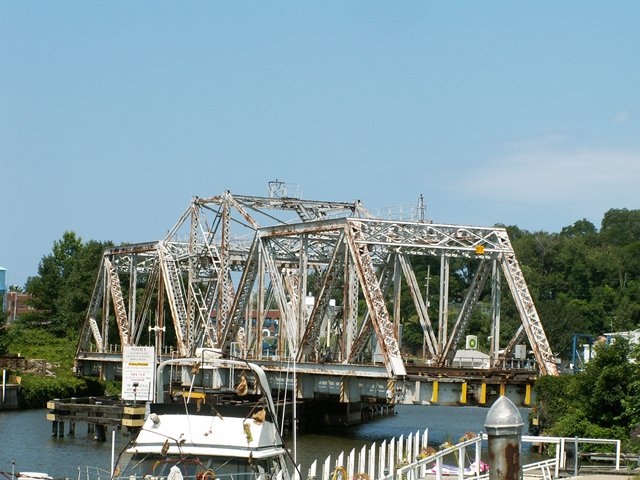We Recommend:
Bach Steel - Experts at historic truss bridge restoration.
Michigan City Railroad Bridge

Primary Photographer(s): Nathan Holth
Bridge Documented: August 12, 2006
Michigan City: La Porte County, Indiana: United States
By Builder/Contractor: Unknown
Not Available or Not Applicable
195.0 Feet (59.4 Meters)
200.0 Feet (61 Meters)
Not Available
1 Main Span(s)
Not Applicable

View Information About HSR Ratings
Bridge Documentation
If you are ever headed to Chicago on I-94 and you find a traffic jam in this area, consider getting off the parking lot and taking US-12 as an alternative route. You can get a chance to stop and check out some nice bridges along the way, including this attractive swing bridge, a short distance off the main road. Alternatively, if you take the Amtrak to Chicago you will actually get to cross this bridge.
This is an impressive swing bridge that is painted in a refreshingly non-black color making it a nice change from most railroad bridges. It is rusting however. The structure is pin connected, and continues to operate for both boats and trains. The bridge appears to remain in the open position in the summer and closes only when a train is coming. As a truss bridge, this is an attractive structure with v-lacing and lattice on various parts of the bridge.
The bridge was built ca. 1905.
Information and Findings From DHPA Historic Bridge SurveyStatement of Significance The truss designer appears to have followed some of Waddell's 1898 prescription that 225'-300' swinging spans ought to be designed as pin-connected Pratt throughs with broken top chords. The reduced use of pins here reflects early twentieth century experience with the extra wear moving spans put on pin connections. This bridge appears to retain its original members, including power source and latticed portals. It is the only structure of this design remaining in Indiana. Architectural Description New York Central trains have crossed Trail Creek over a rim-bearing, partly-pinned Warren through swing span for decades. The top chord is raised in the panel over the rim and connects to the four-panel side sections through heavy die-forged eyebars. Both chords and endposts are fabricated from laced crafted channels. The diagonals crossing the 4th and 6th panels match the outer endposts and include latticed portals; heavy eyebars in the 3rd and 7th panels carry the stresses from the raised central panel; laced crafted channels serve in the 2nd and 8th panels; and a diagonal inserted about one-third of the way up the endpost stabilizes the abutment panel. Pins are used only for the top 3rd, 4th, 5th, and 6th and the bottom 2nd and 7th panel points whose connecting die-forged eyebars carry the extra tension of the ends when the truss is turned. Rectangular girder floor beams carry the timber tie deck and its single track. Bridge Considered Historic By Survey: Yes |
![]()
Photo Galleries and Videos: Michigan City Railroad Bridge
Bridge Photo-Documentation
Original / Full Size PhotosA collection of overview and detail photos. This gallery offers photos in the highest available resolution and file size in a touch-friendly popup viewer.
Alternatively, Browse Without Using Viewer
![]()
Bridge Photo-Documentation
Mobile Optimized PhotosA collection of overview and detail photos. This gallery features data-friendly, fast-loading photos in a touch-friendly popup viewer.
Alternatively, Browse Without Using Viewer
![]()
Maps and Links: Michigan City Railroad Bridge
Coordinates (Latitude, Longitude):
Search For Additional Bridge Listings:
Bridgehunter.com: View listed bridges within 0.5 miles (0.8 kilometers) of this bridge.
Bridgehunter.com: View listed bridges within 10 miles (16 kilometers) of this bridge.
Additional Maps:
Google Streetview (If Available)
GeoHack (Additional Links and Coordinates)
Apple Maps (Via DuckDuckGo Search)
Apple Maps (Apple devices only)
Android: Open Location In Your Map or GPS App
Flickr Gallery (Find Nearby Photos)
Wikimedia Commons (Find Nearby Photos)
Directions Via Sygic For Android
Directions Via Sygic For iOS and Android Dolphin Browser
USGS National Map (United States Only)
Historical USGS Topo Maps (United States Only)
Historic Aerials (United States Only)
CalTopo Maps (United States Only)

